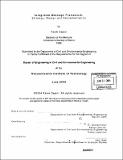| dc.contributor.advisor | George Kocur. | en_US |
| dc.contributor.author | Dajani, Tarek, 1974- | en_US |
| dc.contributor.other | Massachusetts Institute of Technology. Dept. of Civil and Environmental Engineering. | en_US |
| dc.date.accessioned | 2006-03-24T18:22:28Z | |
| dc.date.available | 2006-03-24T18:22:28Z | |
| dc.date.copyright | 2004 | en_US |
| dc.date.issued | 2004 | en_US |
| dc.identifier.uri | http://hdl.handle.net/1721.1/30132 | |
| dc.description | Thesis (M. Eng.)--Massachusetts Institute of Technology, Dept. of Civil and Environmental Engineering, 2004. | en_US |
| dc.description | Includes bibliographical references (leaf 91). | en_US |
| dc.description.abstract | As we subscribe to more and more communication channels our 'world of messages' is becoming a complex matrix of dispersed information. Emailing, Blogging, Instant Messaging... have become customary daily activities for many. While the wealth of media enriches our interaction experiences, it nonetheless constrains our ability to assimilate information from one location (information is stored online, on a local machine, and on the local network) and in one format. As a matter of fact, given our reliance on multiple communication channels, we have to resort to using several distributed applications that lack a unified visual interface and storage structure. Result: 1- Incompatible message description and storage structures. 2- Incompatible message transfer and notification standards. As in the case of Email and Instant Messaging which despite their many similarities are still highly non interoperable. 3- No horizontal visibility across and within message media formats (Email, Blog, IM, etc...) preventing unified searches, correspondence logging and centralized information management. 4- Distributed contact and address repository, preventing access to a unified comprehensive 'Address Book'. Large corporations have the ability to resolve the issues above by forcing a top down standardization policy that regulates correspondence forms and formats between and across their business units. While that approach might prove fairly successful in homogeneous environments, it fails to address the needs of heterogeneous project workgroups which have neither the infrastructure nor the logistics to enforce a unifying framework. | en_US |
| dc.description.abstract | (cont.) This document presents a new approach towards the consolidation of multiple messaging structures (Emails, Blogs, Instant Message Transcripts, File Transfers/Sharing, Calendar Tasks and Events as well as their associated contacts and addresses) into an integrated framework that is accessible via subscriber services within projects. Furthermore, it will explore the possibilities of leveraging individual media properties (such as the concept of Presence in instant messaging) across the entire messaging framework as well as the introduction of intelligent agents that streamline message delivery through prioritized dispatching, scheduled delivery and error, event and task notification. The thesis will cover the implementation of an Intelligent Project Management Client (ILINK) as a working example of the integrated messaging framework (IMF) through the combined use of desktop components, web services, xml transmission schemas, and database storage. The document concludes with a retrospective analysis and an outline of milestones for the extension of the integrated message framework (IMF). | en_US |
| dc.description.statementofresponsibility | by Tarek Dajani. | en_US |
| dc.format.extent | 94 leaves | en_US |
| dc.format.extent | 4154241 bytes | |
| dc.format.extent | 4154049 bytes | |
| dc.format.mimetype | application/pdf | |
| dc.format.mimetype | application/pdf | |
| dc.language.iso | eng | en_US |
| dc.publisher | Massachusetts Institute of Technology | en_US |
| dc.rights | M.I.T. theses are protected by copyright. They may be viewed from this source for any purpose, but reproduction or distribution in any format is prohibited without written permission. See provided URL for inquiries about permission. | en_US |
| dc.rights.uri | http://dspace.mit.edu/handle/1721.1/7582 | |
| dc.subject | Civil and Environmental Engineering. | en_US |
| dc.title | Integrated Message Framework : strategy, design and implementation | en_US |
| dc.title.alternative | IMF : strategy, design and implementation | en_US |
| dc.type | Thesis | en_US |
| dc.description.degree | M.Eng. | en_US |
| dc.contributor.department | Massachusetts Institute of Technology. Department of Civil and Environmental Engineering | |
| dc.identifier.oclc | 56015967 | en_US |
